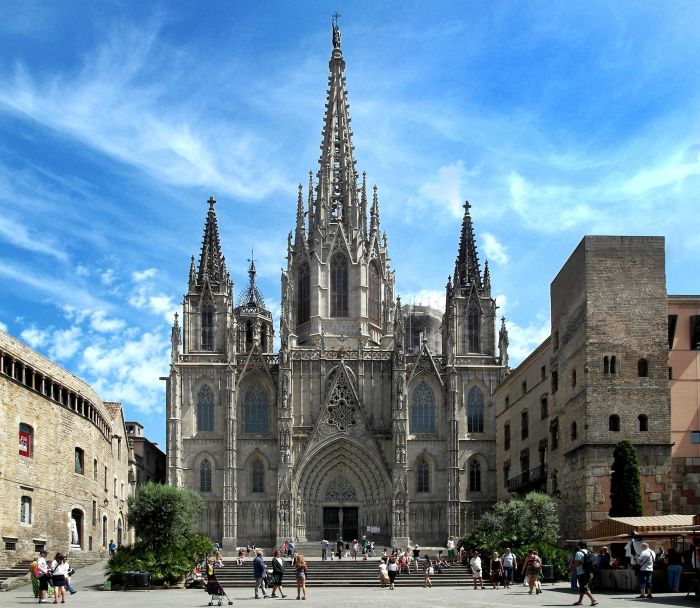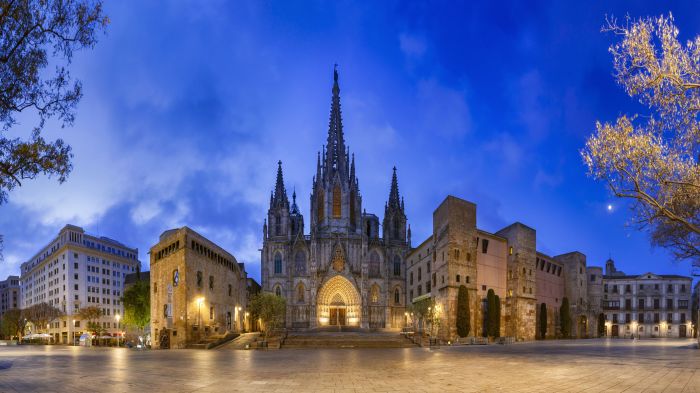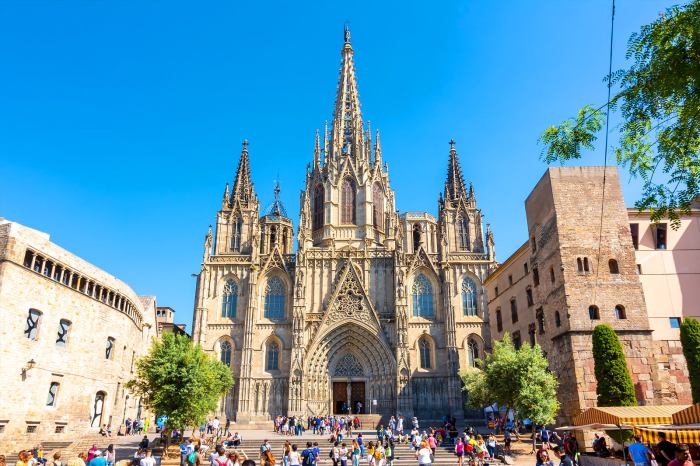Embark on a captivating journey into the heart of Barcelona Cathedral, a breathtaking Gothic masterpiece that stands as a testament to the city’s rich history and artistic heritage. Its soaring spires and intricate façade invite exploration, revealing a world of architectural wonders, artistic treasures, and profound symbolism.
From its origins as a humble Romanesque church to its present-day status as a beloved landmark, Barcelona Cathedral has played a pivotal role in the religious and cultural life of the city. Step inside its hallowed halls and discover a treasure trove of stained glass windows, sculptures, and paintings, each a testament to the skill and devotion of medieval artisans.
Architectural Overview

Barcelona Cathedral, an iconic landmark in the heart of the city, is a masterpiece of Gothic architecture that has captivated visitors for centuries. Its grand exterior and awe-inspiring interior showcase the pinnacle of medieval craftsmanship and artistic expression.
The cathedral’s façade is a symphony of intricate carvings, sculptures, and stained glass windows. The central portal, adorned with a magnificent rose window, leads into a spacious nave, flanked by elegant aisles. Soaring pillars and pointed arches create a sense of grandeur and verticality, drawing the gaze upwards towards the vaulted ceiling.
Exterior
The exterior of Barcelona Cathedral is a testament to the skill and artistry of medieval architects. Its façade, a harmonious blend of Gothic and Baroque elements, features three distinct portals. The central portal, dedicated to the Nativity, is adorned with elaborate sculptures depicting scenes from the life of Christ. The lateral portals, dedicated to the Passion and the Resurrection, are equally impressive, showcasing intricate carvings and vibrant stained glass.
The cathedral’s two towers, known as the Bell Tower and the Lantern Tower, rise majestically above the city skyline. The Bell Tower, completed in the 15th century, houses a collection of 14 bells, including the famous “Honorata,” which weighs over 5 tons. The Lantern Tower, added in the 19th century, provides panoramic views of Barcelona from its observation deck.
Interior
The interior of Barcelona Cathedral is equally breathtaking, characterized by its soaring nave, elegant aisles, and numerous chapels. The nave, the central part of the cathedral, is supported by 28 massive pillars that rise to a height of over 130 feet. The ribbed vaults, adorned with intricate carvings, create a sense of awe and grandeur.
Flanking the nave are two aisles, each lined with a series of chapels. These chapels, dedicated to various saints and guilds, feature stunning altarpieces, sculptures, and stained glass windows. One of the most notable chapels is the Chapel of the Holy Christ of Lepanto, which houses a revered wooden crucifix said to have protected Barcelona from invasion during the Battle of Lepanto.
Historical Significance

Barcelona Cathedral, a majestic Gothic masterpiece, holds immense historical significance that intertwines with the religious, cultural, and social fabric of the city. Its origins trace back to the 13th century, marking a transformative era in Barcelona’s history.
Initially, the site housed a Romanesque cathedral dedicated to Saint Eulalia, the city’s patron saint. However, as Barcelona flourished and its population grew, the need for a grander and more befitting cathedral arose. Thus, in 1298, King Jaume II initiated the construction of the current Gothic cathedral.
Architectural Evolution
The cathedral’s construction spanned centuries, with each era leaving its imprint on the architectural grandeur. The initial Gothic phase, characterized by pointed arches, ribbed vaults, and stained-glass windows, set the foundation for the cathedral’s awe-inspiring presence.
In the 15th century, the addition of the Renaissance-style choir and the intricate cloister further enriched the cathedral’s architectural tapestry. The 19th century brought about the completion of the iconic facade, adorned with elaborate sculptures and spires, which became a defining feature of Barcelona’s skyline.
Religious and Cultural Significance
Barcelona Cathedral has served as the spiritual heart of the city for centuries. It is the seat of the Archbishop of Barcelona and a pilgrimage destination for countless believers. The cathedral has witnessed countless religious ceremonies, including coronations, baptisms, and weddings, cementing its place in the religious and cultural life of Barcelona.
Beyond its religious significance, the cathedral has also played a vital role in the city’s cultural landscape. It houses a renowned choir school, which has produced some of Spain’s most celebrated musicians. The cathedral’s archives preserve invaluable historical documents and artifacts, offering a glimpse into Barcelona’s rich past.
Notable Events and Figures
Throughout its history, Barcelona Cathedral has witnessed numerous significant events and been associated with notable figures. In 1493, Christopher Columbus received a blessing at the cathedral before embarking on his historic voyage to the Americas.
The cathedral has also been the stage for political and social gatherings. In 1714, the city’s leaders gathered within its walls to sign the Act of Surrender, marking the end of the War of the Spanish Succession. These events have further etched the cathedral into the annals of Barcelona’s history.
Barcelona Cathedral, with its awe-inspiring Gothic architecture, is a must-see for any visitor to the city. Its towering spires and intricate facade are a testament to the skill of its builders. If you’re looking for a charming lakeside town with stunning mountain views, consider visiting Annecy , nestled in the French Alps.
While Annecy may not have a grand cathedral like Barcelona’s, it offers a unique blend of history, culture, and natural beauty. Upon returning to Barcelona, be sure to explore the cathedral’s captivating interior, featuring magnificent stained glass windows and an impressive altar.
Artistic Treasures

Barcelona Cathedral is renowned for its impressive collection of artistic treasures, including exquisite stained glass windows, intricate sculptures, and captivating paintings. These artworks not only enhance the cathedral’s aesthetic appeal but also provide valuable insights into the artistic techniques and styles prevalent during different periods of history.
Stained Glass Windows
The cathedral’s stained glass windows are a symphony of vibrant colors and intricate designs. The oldest windows, dating back to the 14th century, depict scenes from the life of Christ and the Virgin Mary. These windows showcase the Gothic style’s characteristic use of pointed arches and vibrant hues.
Later windows, installed during the Renaissance and Baroque periods, display a more naturalistic style. They feature detailed representations of biblical figures and events, as well as scenes from the lives of saints and other religious figures. The windows’ rich colors and intricate patterns create a sense of awe and wonder within the cathedral.
Sculptures, Barcelona cathedral
Barcelona Cathedral is adorned with numerous sculptures, ranging from delicate carvings to imposing statues. The main altar features a magnificent 14th-century altarpiece depicting scenes from the Passion of Christ. The altarpiece’s intricate carvings and lifelike figures are a testament to the skill and artistry of the medieval sculptors.
Barcelona Cathedral, with its Gothic grandeur and intricate details, is a must-visit for families seeking cultural immersion on a budget. While exploring this architectural marvel, consider incorporating other cost-effective activities into your family vacation, as suggested in this comprehensive guide to budget family vacations.
Return to Barcelona Cathedral for a serene moment amidst the bustling city, appreciating its timeless beauty.
The cathedral also houses several impressive sculptures by renowned artists. Among them is the “Pietà” by Jaume Huguet, a poignant depiction of the Virgin Mary cradling the dead Christ. The sculpture’s realistic details and emotional intensity convey the profound grief and sorrow of the scene.
Paintings
The cathedral’s collection of paintings includes works by renowned artists from various periods. One of the most notable paintings is “The Deposition” by Pedro Berruguete, which depicts the removal of Christ’s body from the cross. The painting’s vivid colors and dramatic composition capture the intensity of the moment.
Another significant painting is “The Adoration of the Magi” by Bartolomé Bermejo. This 15th-century masterpiece showcases the artist’s mastery of oil painting techniques and his attention to detail. The painting’s intricate textures and vibrant colors bring the scene to life.
Symbolism and Iconography

Barcelona Cathedral is a treasure trove of symbolism and iconography, each element contributing to its profound spiritual and cultural significance.
Barcelona Cathedral, a magnificent Gothic masterpiece, stands as a testament to the city’s rich history and architectural prowess. Its soaring spires and intricate facade draw visitors from far and wide. While Barcelona Cathedral may be a world-renowned landmark, it’s not the only architectural gem worth exploring.
Just like albany , with its stunning State Capitol and vibrant arts scene, Barcelona offers a wealth of cultural and historical attractions to discover.
The cross, a universal symbol of Christianity, is omnipresent throughout the cathedral. It adorns the main altar, the stained-glass windows, and even the façade, serving as a reminder of Christ’s sacrifice and the triumph of good over evil.
The Rose
The rose, a symbol of love, purity, and the Virgin Mary, is another prominent motif in the cathedral’s artwork. It appears in the stained-glass windows, the choir stalls, and the chapter house, reminding visitors of the cathedral’s dedication to the Mother of God.
The Lion
The lion, a symbol of strength, courage, and royalty, is also present in the cathedral’s iconography. It is depicted in the façade sculptures, representing the power and majesty of God. The lion’s presence also symbolizes the cathedral’s role as a protector of the city and its people.
These symbols, interwoven throughout Barcelona Cathedral’s architecture and artwork, create a rich tapestry of meaning that invites contemplation and inspires awe. They remind visitors of the cathedral’s sacred purpose and its enduring legacy as a symbol of faith and cultural heritage.
Cultural Impact: Barcelona Cathedral

Barcelona Cathedral has played a pivotal role in shaping the cultural identity of the city and beyond. Its architectural grandeur and religious significance have profoundly influenced local traditions, festivals, and artistic practices.
The cathedral is a central figure in the annual La Mercè festival, one of Barcelona’s most important cultural events. The festival features a procession that culminates at the cathedral, where a traditional dance is performed.
Literature and Art
Barcelona Cathedral has been a source of inspiration for numerous literary works, including the novels of Carlos Ruiz Zafón and Ildefonso Falcones. The cathedral’s intricate architecture and historical significance have also made it a popular subject for painters and photographers.
Final Conclusion

Barcelona Cathedral is not merely a building; it is a living testament to the enduring power of faith, art, and human ingenuity. Its towering presence continues to inspire awe and wonder in visitors from around the globe, solidifying its place as a cherished symbol of Barcelona’s cultural and spiritual legacy.
FAQs
What is the architectural style of Barcelona Cathedral?
Barcelona Cathedral is a prime example of Catalan Gothic architecture, characterized by its soaring spires, ribbed vaults, and intricate ornamentation.
What is the history of Barcelona Cathedral?
The origins of Barcelona Cathedral date back to the 13th century, when it was built on the site of an earlier Romanesque church. Over the centuries, it has undergone several renovations and expansions, reflecting the changing artistic and religious tastes of the time.
What are some of the most significant artworks in Barcelona Cathedral?
Barcelona Cathedral houses a wealth of artistic treasures, including stained glass windows by Antoni Gaudí, sculptures by Jaume Huguet, and paintings by Bartolomé Bermejo.